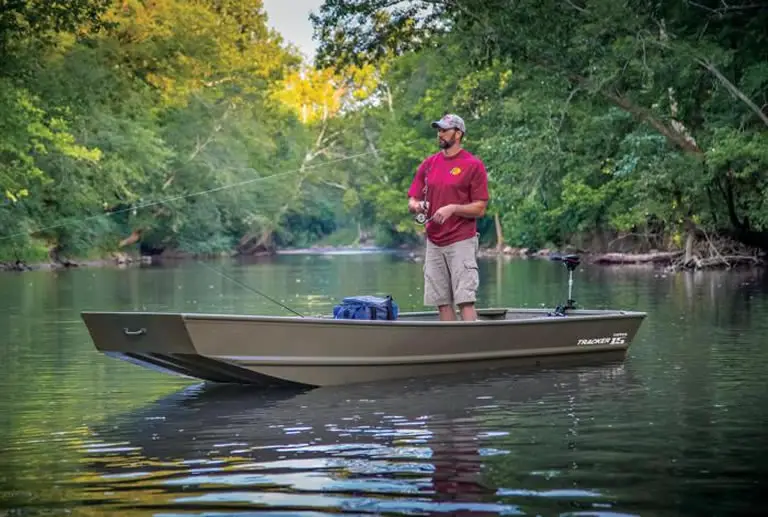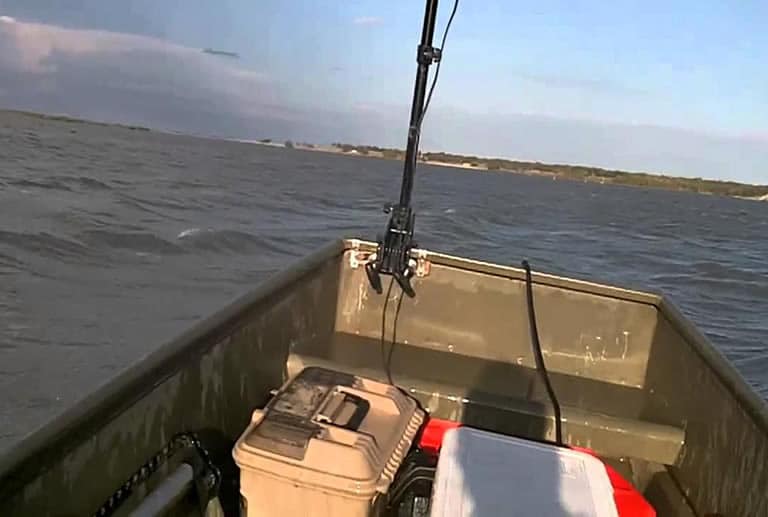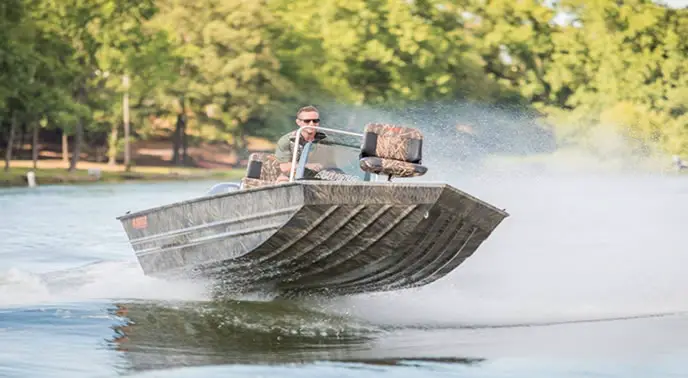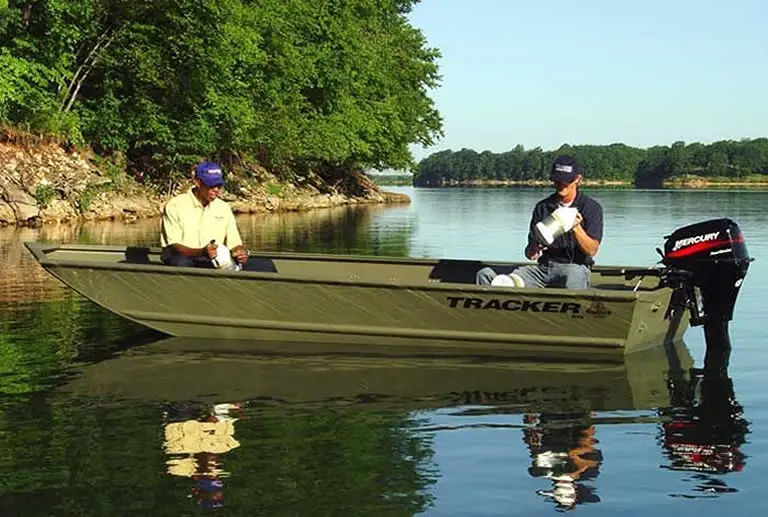Contents
Flat bottom boat benefits – the 5 pros of a shallow water vessel
Flat bottom boats are excellent for shallow water use.
Some flat bottom boats, like a Jon boat, can access areas with only 2″ water depth. This makes them great boats for use on bodies of inland water.
They are great for fishing, hunting and utility work.

They are also incredibly stable on calm water and very comfortable even at speed because they get on plane easily.
Flat bottom boats do not handle rough water well and are unsuitable for ocean use.
Most flat bottom boats are designed for shallow water use.
Of course there are rare exceptions, like the dory boat, but for the most part, a boat is given a flat bottom so it has a shallow draft.
Having a shallow draft, as opposed to a deep draft, allows a flat bottom boat to access shallow areas of water that other boats could simply not enter.
Although not all flat bottom boats have the same draft, almost all of them can be used in shallow rivers, lakes, ponds etc.
5 Pros of a flat bottom boat:
- Superior stability. Flat bottom boats offer incredibly stability on calm water. The large flat surface on the bottom of the boat means it “sits on” the water, rather than “in” it, leading to superior stability when at rest.
- Shallow draft. Flat bottom boats naturally have shallow drafts. This allows them to be used in shallow water.
- Best choice for inland bodies of water. s most bodies of water that lie inland have significant shallow areas a flat bottom boat, with its shallow draft, is the obvious choice for these waters. Even in deep lakes a deep draft boat may not have enough clearance at the bottom to be useful.
- Slipping and sliding. Most flat bottom boats will simply slide over obstacles on the bottom – like a Jon boat.
- Comfortable even at speed. Flat bottom boats offer a very smooth ride at speed because these boats can get on plane quickly.
If you plan to boat on inland waters then you will likely be best served best by a flat bottom boat.
There are a myriad of flat bottom river boats with shallow drafts to choose from, with the most popular being the amazingly versatile Jon boat because of what it can be used for.
Typical uses for a flat bottom boat:
- Shallow water fishing. Fishing in the shallows must be done on a shallow draft boat. However, these boats are also capable of fishing in deeper waters as long as they are relatively calm.
- Waterflowing. The shallow draft allows a flat bottom boat access to shallow banks. The superior stability also allows for safe shooting on the boat.
- Bow fishing. The flat bottom means these boats offer incredible stability for the archer.
- Transportation on inland waters. As most bodies of water that lie inland have shallow areas a flat bottom boat offers better access to all areas.
- Utility work. Flat bottom boats are used on inland waters from canals to rivers and lakes for general utility work. Larger flat bottom vessels, like barges, also haul heavy goods on shallow inland waterways.
Most flat bottom boats can be motorized and/or manually propelled. Smaller vessels can use a trolling motor for speed in deeper waters and paddles, oars and pole for the shallows.
Larger flat bottom vessels, like 16’+ Jon boats or skiffs, can have a powerful outboard motor mounted on them.
Flat bottom boat drawbacks – the 3 cons of an inland waterway vessel
Many flat bottom boats have low freeboard. This means the top parts of the hull, (the top of the sides, bow and stern), sit very close to the water line.
This makes them susceptible to splash.
Boats with low freeboard and a shallow draft do not fair well in rough waters.

The shallow draft, flat bottom hull, does not have enough depth to give the boat stability in rough water while the low freeboard means water splash can easily get into the boat.
This means flat bottom boats and rough water do not mix well.
Where flat bottom boats struggle:
- Rough water. Flat bottom boats do not handle very well in choppy water. In very rough water it can even be dangerous to be in certain flat bottom boats.
- Ocean water. Flat bottom boats are not designed to be used in the ocean. Although you may see some sailing skiffs, scows and even Jon boats in the ocean, a flat bottom boat can only access open waters under very strict conditions.
- River running. Most flat bottom boats should not be used in whitewater rivers. Of course there are exceptions, namely river rafts and drift boats (both of which I cover below), but these flat -bottomed vessels are unique. Most flat bottom boats are not suitable for use in very turbulent water because their shallow draft and low freeboard make them susceptible to taking on water.
So, if you intend to use your boat in deep open waters that experience a lot of chop, a flat bottom boat is not the best choice for you.
However, if you intend to use your boat in both shallow water and choppy water, there is an alternative to both a flat bottom boat and a v-hull boat which I will cover later in this article.
2 Flat bottom boats that are exceptions
There are at least two commonly used flat bottom boats that do not follow the pros and cons rules outlined above.
In fact, they flaunt the rules.
Flat bottom boats that behave differently:
- The raft.
- The drift boat.
Everyone knows what a raft is, whether that be the traditional kind or the more modern rubber variety.
You may not be as familiar with a drift boat though.
The drift boat is a type of dory used on turbulent rivers. If you want to learn more about its design characteristics, such as its uniquely curved shape, and its history you should read this article.
If you’d like to know more about how a drift boat is used read this article.
For the purposes of this post I will just quickly review each of the above boats.
The raft can do things other flat bottom boats can’t
A raft is mostly used in turbulent whitewater rivers.
Rafts are used for river rafting as they can ride rapids up to Class V.
Obviously this makes them completely different to other flat bottom boats.
While most flat bottom boats will struggle in rough water, a raft will excel.
Modern rafts are resilient, durable and a whole lot of fun.
A drift boat, like a raft, is completely different from other types of flat bottom boats.
A drift boat is used for river running as it can easily handle whitewater and can even be used to ride rapids up to Class IV.
Drift boats are not designed to be used stationary.
Unlike most other flat bottom boats, which are incredibly stable while at rest, a drift boat is designed to be a “drifter”.
This boat performs best when it is moving.
Drift boat fishing takes advantage of this unique characteristic by allowing an angler to fish downstream from the bow of the boat while the boat slowly moves upstream under oar power.
The 7 most popular flat bottom boats
We have an entire article covering many different types of flat bottom boats.
However, I have given a short list of the most popular non-commercial flat bottom boats below with links to articles about them.
If you need help choosing a flat bottom boat read our article what is the best flat bottom boat to see how different flat bottom boats are used.
I also encourage you to have a crawl around this website as it is dedicated to flat bottom boats.
If you decide to go down the route of flat bottom, shallow draft, boating then you will find some interesting and valuable information in the pages on this site.
There are many other types flat bottom boats available including drag boats, tunnel hull boats, double wide Jons and many different types of river boats.
An important word about semi-v flat bottom boats
Although semi-v boats are strictly speaking completely flat-bottomed vessels they do have a reputation of being more capable of navigating waters better suited to a v-hull deep draft boat.
As I promised to tell you earlier, these are the boats which are a compromise between a flat bottom hull and a v-hull bow (for slicing through waves).
This unique mod on the boat makes it slightly more stable in rough waters than a standard Jon boat with a squared-shaped bow (but not by much).

A boat with a semi-v hull, sometimes called a mod-v (like a mod-v Jon boat, for example), has been designed to incorporate aspects of a v-hull and aspects of a flat bottom hull.
The reason for this is that many boaters who need a vessels with a shallow draft for accessing shallow areas of inland bodies of water also need something that can handle a bit of rough water. Not all inland bodies of water are calm!
For anglers, hunters and others who use their boats in the shallows and also in more open, choppy water the semi-v boat was created.
This boat has a shallow enough draft to be used on inland waters but its pointed bow and slight “v” shaped hull allows it to ride rough water much better than a completely flat-bottomed boat.
Just remember that a semi-v flat bottom boat (mostly Jon boats) is subject to the same constraints as any other flat bottom boat (with the exception of the raft and the drift boat, as mentioned above).
If you are interested in learning more about the differences between a semi-v, shallow draft boat and a flat bottom, shallow draft boat read our article flat bottom Jon boat vs mod-v Jon boat.
Although that article is about Jon boats it applies to all flat bottom and semi-v vessels.

